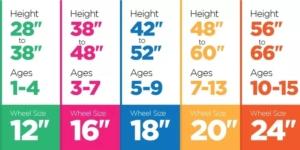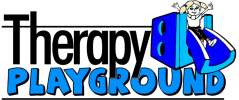With the holidays coming up, purchasing toys that encourage your child’s motor development are a great opportunity to get your child engaged and motivated while also promoting gross motor skills. We’ve put together a list for you of varying toys on wheels to get your child motivated and moving. It is important to note that the age ranges listed are to give you a general idea of when these toys are used. Keeping in mind every child is different and they progress through milestones at their own pace.
1. Push toy
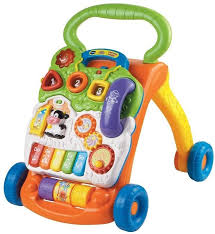
A push toy is great for emerging or new walkers. It allows them to hold onto a support while they learn to maintain their balance and take steps. You can have your child play on their knees, or walk on their knees, while holding the push toy from the front. With the example provided in the picture, you can remove the tablet piece and tie mardi-gras beads or other motivating toys around the handle bar to fall in the front of the toy for different sensory exploration. You can progress to having your child stand behind the toy and walk while holding onto the handle. One tip is to weigh the push toy down to help your child control the speed while they learn to take steps using bags of rice or soup cans if your push toy allows the space for it (shopping carts, for example). Most push toys have resistance controls on the wheels to help control the speed as well.
2. Riding toy
A riding toy is great for general strengthening, coordination, and balance for kids 1-3 years old. Have your child practice getting on and off the riding toy by themselves to work on balance and standing on one leg. Once seated on the toy, they have to engage their tummy muscles to stabilize themselves as they learn to propel themselves forward and backwards with their legs. Encouraging them to move forward using one leg, then the other (reciprocal movement) rather than both feet together will help with carry over for walking and running. This is a great toy to build leg strength for other gross motor activities.
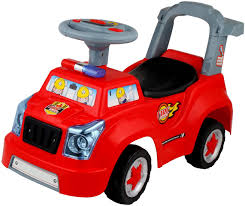
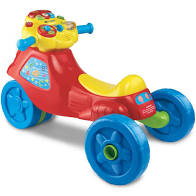
3. Tricycle
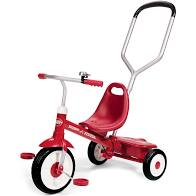 Tricycles, such as the Radio Flyer, are a great precursor to bike riding. Most children learn to ride a tricycle around 3 years old. Tricycles encourage reciprocal movement (moving one foot then the other). Many gross motor skills involve reciprocal movement such as walking, running, and stairs. The great thing about tricycles is the pedals automatically rotate when the bike is moved. If your child is unable to pedal independently, their legs will still move as if they are pedaling themselves, even if the caregiver is doing all of the work. This is great to encourage motor planning and to build the leg strength needed for pedaling. If your child has difficulty keeping their feet on the pedals, try tying a piece of thera-band or velcro straps to the pedals to secure their feet. Make sure the tricycle is sized to your child.
Tricycles, such as the Radio Flyer, are a great precursor to bike riding. Most children learn to ride a tricycle around 3 years old. Tricycles encourage reciprocal movement (moving one foot then the other). Many gross motor skills involve reciprocal movement such as walking, running, and stairs. The great thing about tricycles is the pedals automatically rotate when the bike is moved. If your child is unable to pedal independently, their legs will still move as if they are pedaling themselves, even if the caregiver is doing all of the work. This is great to encourage motor planning and to build the leg strength needed for pedaling. If your child has difficulty keeping their feet on the pedals, try tying a piece of thera-band or velcro straps to the pedals to secure their feet. Make sure the tricycle is sized to your child.
4. Bicycle
 Around 4-5 years old is when children start learning how to ride a bike with training wheels, progressing to riding without training wheels around 6-7 years old (depending on a variety of factors). You can remove the pedals and training wheels initially and just have your child work on sitting on the bike for balance. Then you can add them back on to practice pedaling. A great tip when learning how to ride a bike with or without training wheels is to wrap a beach towel, jacket, sheet, etc around your child’s waist for you to hold. This allows you to still support your child when riding without having to place your hands directly on your child, allowing them to do more of the work and get a feel for balance. The tighter you hold the towel, the more support you provide. Also remember helmet safety!
Around 4-5 years old is when children start learning how to ride a bike with training wheels, progressing to riding without training wheels around 6-7 years old (depending on a variety of factors). You can remove the pedals and training wheels initially and just have your child work on sitting on the bike for balance. Then you can add them back on to practice pedaling. A great tip when learning how to ride a bike with or without training wheels is to wrap a beach towel, jacket, sheet, etc around your child’s waist for you to hold. This allows you to still support your child when riding without having to place your hands directly on your child, allowing them to do more of the work and get a feel for balance. The tighter you hold the towel, the more support you provide. Also remember helmet safety!
Here is one example of a bike sizing chart found online (schwinnbikes.com). There are many examples found online, with slightly varying information. Please consult your local bike shop if you have any questions regarding sizing.
